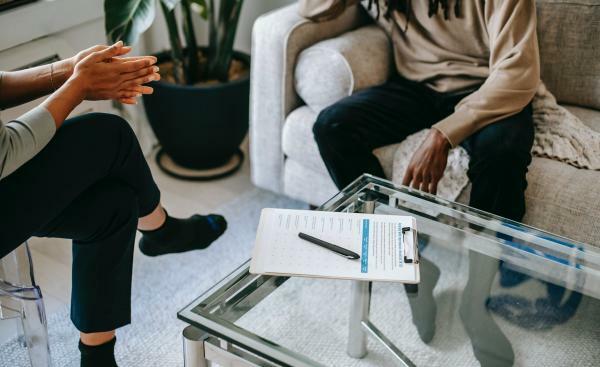
Dysthymia is a depressive disorder included in the main diagnostic classifications DSM-5 (American Psychiatric Association) and ICD-11 (World Health Organization). As such, it is necessary for a professional to determine the best intervention strategies for the specific case he is treating.
Understanding that "getting out of dysthymia" supposes the remission of the symptoms of the dysthymic picture, we must be aware that we will not be able to achieve this remission by ourselves. However, in this article, we offer you some guidelines and some tips that are in your power and will undoubtedly and positively contribute to the work of the professional who handles your case. Continue reading this Psychology-Online article in which we explain how to get out of dysthymia through 8 psychological strategies.
Index
- Seeking professional help
- Collaboration between the professional and the patient
- Follow the professional's recommendations
- Do enjoyable activities
- Feeding
- Dream
- Perform physical exercise
- Search for social support
Seeking professional help.
The dysthymic disorderAs such, you must be seen by a mental health professional. It is important for the patient to go to a consultation so that the professional can assess their particular case and decide which will be the best intervention.
It is possible and common for patients to notice improvement that takes them away from seeking professional help. Although it seems that the problem is remitting on its own and without help or although the degree of discomfort may fluctuate over time, we emphasize the importance of going to the professional's consultation.
We must also bear in mind that the difference constitutes a depressive disorder which, by definition, has a long history of duration in the patient. It is a disorder that, if not treated, will tend to become chronic. Here are some important tips on what to do to overcome dysthymia.
Collaboration between the professional and the patient.
The patient and the therapist must form a team that works together to achieve the therapeutic objectives that both have agreed upon (in this case, the reduction of the depressive).
Among the many variables that can influence the intervention, there are variables that depend on the relationship established by the therapist and the patient and, within them, variables that depend directly on the patient.
How does a person with dysthymia behave? Within the depressive pictures, the appearance of hopelessness, demotivation, fatigue and loss of energy, etc. is common. Taking into account the limitations caused by said symptoms, the patient should try to collaborate with the psychologist: answering her questions as clearly as possible, being completely sincere or sincere and trying to help her in her work.
Follow the professional's recommendations.
Although it depends on the way of working of the psychologist, it is possible that this tasks that the patient must perform between sessions and guidelines that she should implement as directed.
If the case is being treated by a psychiatrist, it is very likely that he will prescribe antidepressant medication. It is also important that the patient follow the guidelines and take the prescribed dose as the professional has indicated. If you want to know the medication for dysthymia, we recommend the following article about types of antidepressants.

Do enjoyable activities.
People with depressive disorders such as dysthymia frequently experience unpleasant emotions. It is important to compensate for this balance by activities that provide gratification, that you enjoy and that motivate you. Thus, you will experience pleasant emotions that will help the intervention in a very positive way. psychological or psychiatric treatment being carried out, therefore, it will help to overcome the dysthymia.
Feeding.
In the face of any psychological disorder, it is important to maintain a healthy life style. It is possible that the depressed patient may experience an increase or decrease in his desire to eat. We must maintain an eating habit that attends to:
- The quality of the food: consumption of nutritious food and maintenance of a healthy and balanced diet.
- The amount in the intake: It is important to eat all the daily meals, feel satisfied and avoid binge eating.

Dream.
Another factor to take into account regarding healthy lifestyle habits is sleep, as it helps to properly maintain biological rhythms and whose desynchronization negatively affects our state of spirit. In this regard, in the same way that occurs in food, we must attend to:
- The quality of sleep: It should be restorative, so that when we get up we feel rested.
- Amount of sleep: we must sleep enough hours according to our age.
To achieve this, you can rely on the following sleep hygiene guidelines.
Perform physical exercise.
Establishing healthy lifestyle habits helps improve physical and mental health, therefore these habits will be a good ally in the intervention on dysthymia. Practice any sport, go for a run or a walk It can help us reduce anxiety levels, and this is usually related to depressive problems and appear together.
Besides, the endorphin release During the practice of physical exercise it will have a positive effect on our mood. In this article we specifically explain How to release endorphins.
Search for social support.
The support that the patient receives from the people around him (friends, family, partner, coworkers, etc.) will contribute positively to his recovery. However, in depressive disorders an isolation of the patient from her social environment may appear.
Therefore, it is important encourage the dysthymic patient to plan with her environment and lean on it sharing your problems, concerns, emotions, etc.
Close people can play a very important role in the dysthymia intervention process, since if the case requires it, they can receive instructions from the professional and act as co-therapists.
What to say to a person with dysthymia? That we are by your side and that you can count on us to talk or carry out any activity.
This article is merely informative, in Psychology-Online we do not have the power to make a diagnosis or recommend a treatment. We invite you to go to a psychologist to treat your particular case.
If you want to read more articles similar to How to get out of dysthymia, we recommend that you enter our category of Clinical psychology.
Bibliography
- American Psychiatric Association (2014). DSM-5. Reference guide to the diagnostic criteria of the DSM-5-Breviary. Madrid: Editorial Médica Panamericana.
- World Health Organization (WHO) (2018) International Classification of Diseases, 11th revision. Recovered from https://icd.who.int/es


